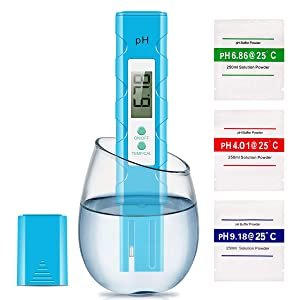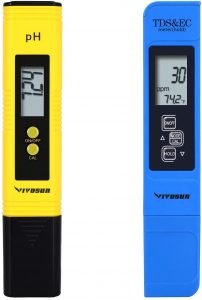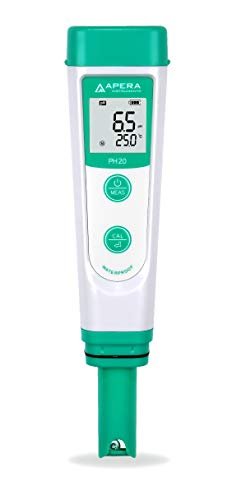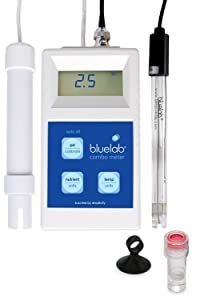In this article we explain KH and its importance to the aquarium and we show how to Raise KH in Aquarium water. We also address GH and pH as all these water measurements are interrelated.
KH is also known as Carbonate Hardness. Its the parameter which can change the most on a daily basis in an aquarium or pond. Carbonate hardness blocks natural acidity and stabilizes pH levels in fish ponds. KH increases and stabilizes the pH.
The greater the KH, the more resistant the aquarium water will be to pH changes. Having a higher KH should prevent large pH swings in your tank over time.
If your tank’s KH level is below 4.5 dKH, you should pay special attention to your tank’s pH. It is advisable to test weekly, until you understand how stable the pH is.
Understanding pH, KH and GH
Prices pulled from the Amazon Product Advertising API on:
Product prices and availability are accurate as of the date/time indicated and are subject to change. Any price and availability information displayed on [relevant Amazon Site(s), as applicable] at the time of purchase will apply to the purchase of this product.
pH
pH stands for Power of Hydrogen. pH gauges the Hydrogen Ions in your aquarium. It shows acidity and alkalinity. pH is measured on a scale of 0-14. High pH means alkaline, low pH means acidic and a reading of 7 is neutral.
Different fish have different tolerances of pH. Most aquarium fish thrive in a neutral pH water of somewhere between 6.5 and 8.
Small fluctuations in pH will cause no harm to your fish, however, a big spike in pH levels is harmful.
KH
The KH (carbonate hardness) measures the carbonate and bicarbonate ions in your aquarium. KH is the ability of water to keep the pH stable (buffering capacity). KH neutralizes the acids present in the aquarium water. This prevents the pH from crashing. pH crashes can harm and potentially kill your fish.
An inadequate buffering capacity is indicated by A low KH level and results in fast pH swings. Whilst, if the KH is high, your aquarium water has a higher buffering capacity, making it harder to change the pH level.
The ideal KH level for a freshwater aquarium is somewhere between 4 – 8 dKH or 70-140 ppm.
GH
GH refers to the general hardness of the water. It is a reading telling you the amount of calcium and magnesium ions present in the water. GH measures the ‘hardness’ or ‘softness’ of your water. It is recommended to have a GH level between 4 – 8 dGH. A low GH can affect the health of plants and fish.
How are pH, KH and GH related?
Although pH, KH, and GH are measurements of specific ions, they are interrelated and all play a part in balancing water chemistry. When minerals are added to the aquarium, they release many ions that affect water parameters.
Limestone, for example, contains a higher level of calcium carbonate. By having both calcium and carbonate ions, you raise both GH and KH when added. Salt mixes specifically created to raise either GH or KH can be purchased.
KH is directly effects pH. It buffers the pH, preventing it from changing rapidly. pH levels tend to decrease in fish aquariums over time. By raising the KH more acids are neutralized, and pH stays higher.
For example, by adding a buffering agent such as crushed coral to a tank with a higher pH level will only raise the KH, not the pH value. Yet, by adding crushed coral to lower pH water will increase both pH and KH values.
If the KH in your aquarium falls, you need to increase the carbonates and bicarbonates in the tank. Commercially prepared alkalinity buffers can be purchased and can be used to raise the KH in your freshwater aquariums. These products make it easy.
Crushed coral combined with aragonite is a perfect alkalinity buffer. The advantage is that it changes KH slowly and steadily.
Why is KH important to your aquarium?
pH Fluctuations
The main benefit of having higher KH levels is its effect on pH. KH inhibits pH levels from becoming to low (extremely acidic). It also stabilizes pH, preventing pH crashes and excessive fluctuations. A rapid change in pH affects many aquarium species. Chemical parameters such as pH are crucial to aquatic life in aquariums and ponds.
KH and marine aquariums
KH is important when it comes to corals in saltwater aquariums.
Corals can survive a broad range of Phosphate levels, however, if the KH is too low for an extended period, all aquarium corals will die.
KH naturally reduces with time due to natural processes and coral growth. When its level is low this can contribute to the pH being low. The ideal KH value for a reef aquarium is between 8 & 12 (3 – 5 meq/l).
A low KH can be corrected by adding Reef Builder or Seachem Reef Carbonate.
KH Influence On Plant Growth In A Freshwater Aquarium
With aquarium plants, the preference for alkalinity is not always discussed.
KH has no real benefit to plants (neither does it harm plants). However, KH affects pH, and a high or low pH may not be suitable for certain species of aquarium plants.
Carbonate hardness stabilizes water quality, so its influence is natural. The number of aquarium plants that survive in very soft water is relatively low.
High pH levels can impede the uptake of nutrients by plants.
Soft water plants prefer higher temperatures and lower KH. Hard water plants with moderate pH preferences can still survive at low KH levels.
How to raise KH in aquarium water
1. Potassium Bi-Carbonate
Understanding how to raise KH in aquarium water is quite simple. In a planted aquarium this is best done by adding KH2CO3 or K2CO3 (Potassium bi-carbonate/carbonate). A double benefit is that the potassium acts as fertilizer for plants as well.
- 3.5 gms of KHCO3 in 100 litres (26 gals) of water raises KH by 1 dKH.
- 2.5 gms of K2CO3 in 100 litres (26 gals) of water raises KH by 1 dKH.
2. Limestone or coral chips
Another simple method to raise the KH levels is by putting pieces of limestone into the filter, the sump or into the tank. Coral chips in a bag work well, although we recommend limestone over coral chips as larger stone is easier to handle and remove.
Tanks with limestone naturally have higher KH levels. The quality of the limestone/coral chips will determine how quickly the KH will rise. Usually from 0 to 10 within a week.
3. Dolomite Rock
Dolomite rock (CaMgCo3) can also slowly raise and maintain a steady KH in your tank. It gradually releases magnesium, calcium, and carbonate in your aquarium. These elements cause the KH to rise. An advantage of dolomite rock is its appearance that looks great as a substrate. This option is ideal for aquariums that require a constant high KH.
4. Aragonite
Aragonite is another natural carbonate mineral that is aquarium fish safe. This mineral provides a constant source of KH enhancer. Smaller tanks require smaller pieces of aragonite and larger tanks, more. Place in the tank or in the sump tank.
5. Soda Ash
With saltwater tanks use Soda ash. Soda ash is not suitable for freshwater as it releases excess sodium into the water in mineral form. Add small quantities over a period as it will instantly raise the KH and pH in an aquarium. Test and monitor the water with a KH test kit to ensure the level is not too excessive.
6. Baking Soda
To increase the KH without raising the GH, you can add sodium bicarbonate (NaHCO3), commonly known as baking soda. By adding one teaspoon per 50 liters (13 gallons) raises the KH by about 4 dH.
7. Water changes
Conducting water changes by removing a third of the tank’s water and replacing with a water source high in KH will help gradually increase KH. Many tap water sources are quite high in KH. Always test the water so that you know what you are adding.
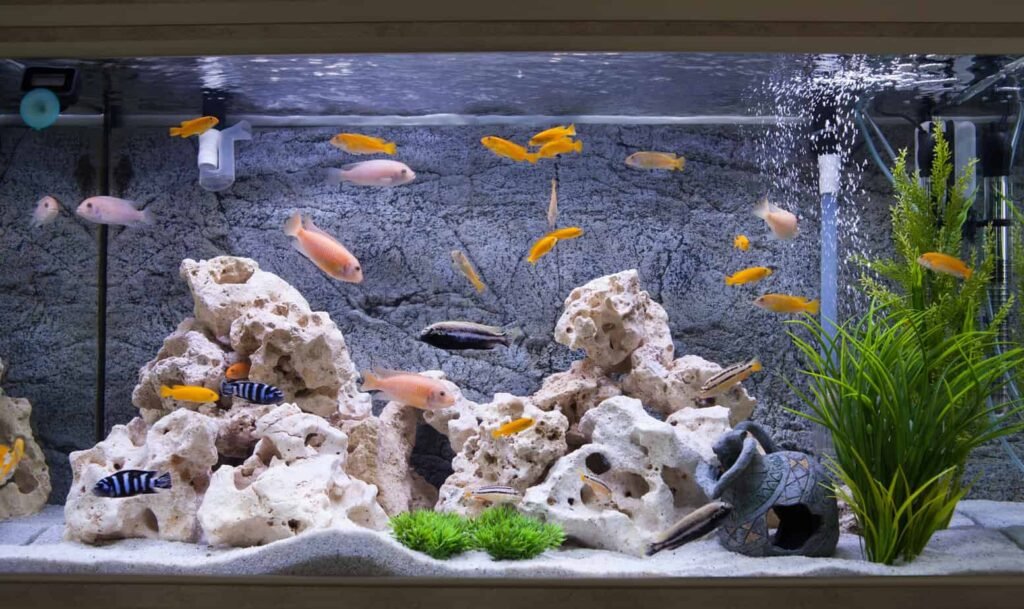
What is the ideal KH level for aquariums?
KH is measured based on dKH (degree KH) and ppm (parts/Million, 1dKH equals 17.9 ppm of calcium carbonate per liter). Each fish species has its specific KH value requirement.
- Brackish water: 10 – 18 dKH
- Planted aquarium: 3 – 8 dKH
- Shrimp aquarium: 2 – 5 dKH
- Cichlid aquarium: 10 – 18 dKH
- Pond: 4 – 8 dKH
- Discus aquarium: 3 – 8 dKH
- Tropical fish aquarium: 4 – 8 dKH
- Marine reef aquarium: 8 – 12 dKH
- 🐠 KEEP YOUR AQUARIUM OR POND HEALTHY - Monitoring your aquarium’s water quality is the most important thing for keeping tropical fish healthy and vibrant, and your tank looking beautiful.
- 🐠 QUICK & EASY TO USE - Designed by experts, this 6 in 1 freshwater aquarium test kit is fast and easier to use than liquid test kits. Aqua Care Pro strips are wider and have non-bleeding colors, making them easier to hold, dip, and read.
- 🐠 DESIGNED FOR AQUARIUMS AND PONDS - Aqua Care Pro strips test for General Hardness (GH), Nitrite, Nitrate, pH, Carbonate Hardness (KH), and Chlorine. The test results are in the proper range for aquarium and pond keeping.
- 🐠 ECONOMICAL PACKAGING - Why buy more strips than you need? This kit includes 104 + 12 strips for testing twice a week (one year’s supply + 12 extra strips). Half of the strips are packaged separately to maintain freshness.
- 🐠 24/7 CUSTOMER SUPPORT - The test kit includes detailed instructions for testing, understanding your results, and an e-book with helpful tips written by 30+ year industry experts. You’ll also have 24/7 access to our expert US-based aquatic biologists.
- 🐠 KEEP YOUR AQUARIUM OR POND HEALTHY - Monitoring your aquarium’s water quality is the most important thing for keeping tropical fish healthy and vibrant, and your tank looking beautiful.
- 🐠 QUICK & EASY TO USE - Designed by experts, this 6 in 1 freshwater aquarium test kit is fast and easier to use than liquid test kits. Aqua Care Pro strips are wider and have non-bleeding colors, making them easier to hold, dip, and read.
- 🐠 DESIGNED FOR AQUARIUMS AND PONDS - Aqua Care Pro strips test for General Hardness (GH), Nitrite, Nitrate, pH, Carbonate Hardness (KH), and Chlorine. The test results are in the proper range for aquarium and pond keeping.
- 🐠 ECONOMICAL PACKAGING - Why buy more strips than you need? This kit includes 104 + 12 strips for testing twice a week (one year’s supply + 12 extra strips). Half of the strips are packaged separately to maintain freshness.
- 🐠 24/7 CUSTOMER SUPPORT - The test kit includes detailed instructions for testing, understanding your results, and an e-book with helpful tips written by 30+ year industry experts. You’ll also have 24/7 access to our expert US-based aquatic biologists.
- 🐠 KEEP YOUR AQUARIUM OR POND HEALTHY - Monitoring your aquarium’s water quality is the most important thing for keeping tropical fish healthy and vibrant, and your tank looking beautiful.
- 🐠 QUICK & EASY TO USE - Designed by experts, this 6 in 1 freshwater aquarium test kit is fast and easier to use than liquid test kits. Aqua Care Pro strips are wider and have non-bleeding colors, making them easier to hold, dip, and read.
- 🐠 DESIGNED FOR AQUARIUMS AND PONDS - Aqua Care Pro strips test for General Hardness (GH), Nitrite, Nitrate, pH, Carbonate Hardness (KH), and Chlorine. The test results are in the proper range for aquarium and pond keeping.
- 🐠 ECONOMICAL PACKAGING - Why buy more strips than you need? This kit includes 104 + 12 strips for testing twice a week (one year’s supply + 12 extra strips). Half of the strips are packaged separately to maintain freshness.
- 🐠 24/7 CUSTOMER SUPPORT - The test kit includes detailed instructions for testing, understanding your results, and an e-book with helpful tips written by 30+ year industry experts. You’ll also have 24/7 access to our expert US-based aquatic biologis
Prices pulled from the Amazon Product Advertising API on:
Product prices and availability are accurate as of the date/time indicated and are subject to change. Any price and availability information displayed on [relevant Amazon Site(s), as applicable] at the time of purchase will apply to the purchase of this product.
How to decrease KH?
There are several ways to decrease KH levels in the aquarium. Increase the tannin in the water by adding Indian Almond leaves (particularly when housing Betta fish), or by using peat. As the leaves or peat break down in the water they gradually begin to use up the KH, this lowering it.
Another method is to mix distilled water with the tank or tap water. Distilled water contains no minerals, therefore no KH. By blending it with the tank water KH levels are reduced.
Having an abundance of aquarium plants will help reduce KH when used with a buffer. These buffers are typically utilized by the live plants to reduce the excessive CO2 from aquarium water. Plants use the buffer to convert KH to CO2.
Products to Increase KH Comparison Table
 | Continuum Aquatics KH+ Alkalinity Booster & pH Stabilizer for Freshwater Aquariums, 500g | PrimeEligible | View on AMAZON | |
 | API pH UP Freshwater Aquarium Water pH Raising Solution 4-Ounce Bottle | PrimeEligible | View on AMAZON | |
 | NilocG Aquatics | REKHARB | Liquid KH Booster 500ml | PrimeEligible | View on AMAZON | |
| Liquid Marine Buffer, 250 mL / 8.5 fl. oz. | PrimeEligible | View on AMAZON | ||
| Seachem Reef Carbonate 500ml | PrimeEligible | View on AMAZON |
How To Test And Measure KH In An Aquarium?
Carbonate hardness can be easily measured using KH-based tests. Ensure you have a quality test kit for your specific aquarium (marine or freshwater). Set up a schedule for water tests, being prepared if water adjustments need to be made.
Test pH and water hardness (GH) at the same time.
The greatest fluctuations in water chemistry usually occur when new water is introduced to the tank after cleaning or during part water changes. It is recommended to test the water you introduce. If the KH is above acceptable levels, use the suggestions above on how to raise KH in aquarium water, to correct them.
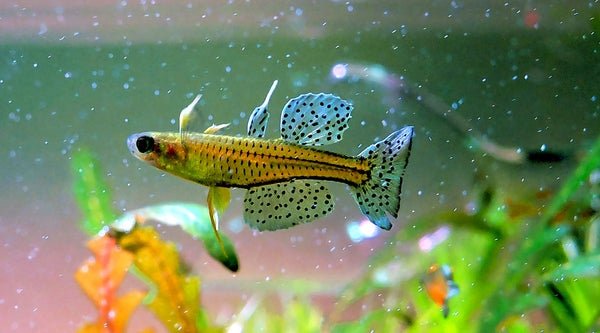
FAQ – How to raise KH in aquarium water?
Will increasing KH increase my pH?
Yes, they are related. In general, a higher KH will result in a higher pH. The pH will also be more stable (reduced fluctuations).
What causes KH to drop in a freshwater aquarium?
KH can drop as the rate at which acids are being produced in the tank is accelerated. The acids ‘eat’ at the water’s carbonates/bicarbonates.
Having too many fish, or adding too many at once can increase acids. Ammonia build-up due to fish wastes, excess food and organic matter decomposition also increase acids. Once KH levels are too low for pH stability, the aquarium will likely have a pH crash.
What affect do frequent water changes have on KH?
As fish wastes build up in a tank, so does the acid level, thus reducing KH. Periodic partial water changes remove the polluted water, replacing it with new clean water. This will restore the KH level.
If you have a larger tank that has a good biological filter and a sump tank, the need for water changes will be far less. The beneficial bacteria in a ‘cycled’ tank will eliminate the nitrates and ammonia from the water. Smaller tanks will require regular water changes.
Also, the water you add during a water change will often have a higher KH. This will be determined by where the water is sourced from.
What happens when there is too much CO2?
CO2 supplementation can provide vital nutritious energy for the beautiful growth of different aquatic plant species. Adding CO2 to the aquarium lowers carbonate levels, causing acidification in your aquarium. Having a high KH will prevent problems and keep the pH at an acceptable level.
What happens when the aquarium is overcrowded?
Inherently, unstable conditions occur when aquariums are overcrowded. Fish waste will cause acidification causing KH levels to drop, risking a pH crash. A drop will cause your fish to stress and the less hardy species will start to die.
Having enough water in your aquarium is the best method to improve the health and stability of your aquarium. Using a sump tank will increase its volume. In addition, efficient biological filters will allow for higher stocking rates.

How to reduce hardness in aquariums?
The difference between KH and GH.
Carbonate hardness (KH) is measured by measuring the amount of carbonate and bicarbonate in water.
Whilst GH is a measure of dissolved magnesium and calcium ions. This is what people usually mean when they refer too water being “soft” or “hard”. Generally, plants and most tropical fish and shrimp do best in a dH range of 4-8 dH (degree hardness). This is considered somewhat soft.
Tap water can have both high GH and low KH, therefore, not always ideal for your fish.
How to soften water?
In order to reduce the hardness of water use peat moss or drift wood. This process works by binding calcium and magnesium ions. It will also release tannic and gallic acid into the water. These acids attack and degrade bicarbonates in the fish aquarium, thus further reducing the carbonate levels and the waters PH level.
Place the peat inside the aquarium filter to allow for maximum flow through the peat.
Alternatively, clean rain water is considered ‘soft’ and can be mixed with tank water to reduce hardness.
Final Thoughts – How to raise KH in aquarium water?
The secret to keeping aquatic live healthy, stress free with a strong immune system is to ensure they have optimal water. Keeping water parameters balanced and within the best range for the species of life in your tank is important.
Understanding KH, pH and GH, and scheduling in regular water tests, will ensure that you are alerted to any water issues. Knowing this will provide peace of mind and will likely save you from much heart-ache.
Understanding how to raise KH in aquarium water is core to maintaining steady pH and keeping water hardness within parameters.
.





